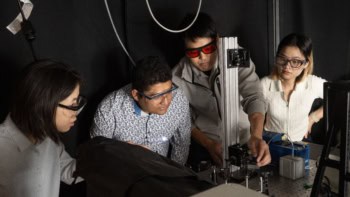With the Physics World 2019 Breakthrough of the Year announced on 12 December, Physics World journalists look back at the past decade of winners and explore how research in that field has moved on. Here Hamish Johnston reflects on the 2018 breakthrough award to Pablo Jarillo-Herrero of the Massachusetts Institute of Technology (MIT) in the US and colleagues for making the discovery that led to the development of “twistronics”, which is a new and very promising technique for adjusting the electronic properties of graphene by rotating adjacent layers of the material.

Calling graphene a “wonder material” may sound trite, but it is an eminently suitable moniker for a material that continues to amaze condensed-matter physicists like MIT’s Pablo Jarillo-Herrero. I chatted with him on the phone from Cambridge, Massachusetts last week to find out what has happened since his team revealed last year that “magic angle graphene” is both a high-temperature superconductor and a Mott insulator.
Before I update you on the state-of-the-art, a little background on the breakthrough. Graphene is a free-standing sheet of carbon just one atom thin that was first isolated just 15 years ago. Layers of graphene stack upon each other to make the familiar material graphite. Twisted graphene can be made from two sheets of graphene by rotating one sheet away from the usual stacking angle.
Our discovery is the tip of the iceberg, there is so much more underneath
Pablo Jarillo-Herrero
Jarillo-Herrero has been working on twisted graphene since 2009. Last year his team reported how they had stacked two sheets of graphene on top of each other and then twisted the sheets so that the angle between them was 1.1°. At this theoretically-predicted “magic angle”, the team had expected to observe a range of interesting physics. This is because carbon atoms in the two overlapping graphene crystals create a moiré superlattice (see figure).
Two very important discoveries
They were not disappointed and made two very important discoveries. First, they found that magic-angle graphene is a Mott insulator. This is a material that should be a metal but is instead an insulator because of strong interactions (correlations) between electrons.
Then, they added a few extra charge carriers to this insulator state by applying a small electric field, which turned the material into a superconductor at temperatures below 1.7 K. Despite the low temperature, the proximity to the Mott insulator state and low electron density of the material mean that the material resembles a high-temperature superconductor.
So Jarillo-Herrero had created a system where small adjustments in terms of angle and electric field creates two iconic states of condensed matter physics – a Mott insulator and a high-temperature superconductor.
What happened next?
Despite it being less than two years since Jarillo-Herrero’s team described its results in two papers in March 2018, the work has been cited over 1000 times. He says that most of the citations are from theorists and that there are now hundreds of theory groups working on the system. It takes longer for experimentalists to learn how to make and characterize magic-angle graphene, but Jarillo-Herrero reckons the are about 20–25 experimental groups that already have results on the material.
Despite this huge effort, the physics of magic angle graphene still in its infancy and Jarillo-Herrero says there are many things to learn and study. Beyond superconductivity and the strongly correlated states – both of which occur at low temperatures – he says that there is much to learn about the material at higher temperatures.
He is also keen at studying other 2D materials that can be twisted. One possibility is bilayer graphene on top of bilayer graphene with a twist between the two bilayers. Twisted bilayers are expected to have interesting correlated-electron physics with magnetic properties that are different to those of the original twisted graphene.
Moiré magnetism
His team is also looking at twisting materials unrelated to graphene such as 2D superconductors and 2D magnets. There are theoretical predictions, for example, that a special kind of magnetism called moiré magnetism occurs when 2D magnets are twisted on top of each other.
“Our discovery is the tip of the iceberg, there is so much more underneath,” he says, “There is a lot of work for many years to come”.
I also asked Jarillo-Herrero about the technological applications of magic-angle materials and his response was frank and honest. “Don’t expect any applications in for 30-40 years – which is the normal time scale for a new material.”
Superconducting transistor
He believes that one technology that could emerge is a superconducting transistor that can be switched between superconducting and normal states. Such devices could be used in “cryogenic classical computers”, which would run at very low temperatures to avoid the power dissipation problems associated with high-speed silicon processors. Other options include using twisted materials to make superconducting singe-photon detectors or superconducting quantum bits for quantum computing.

Ferromagnetism appears in twisted bilayer graphene
However, he points out that the technology is still in its infancy in terms of making large and consistent samples of twisted materials.
In the nearer future, Jarillo-Herrero says that magic-angle materials have a wide range of fascinating physics that will be explored. One avenue is “quantum simulation”, whereby twisted graphene is used as a proxy for a more complicated material such as a high-temperature superconductor.
And, of course, he points out that there should be lots of interesting physics – including topological properties — lurking in twisted graphene itself – which will keep researchers busy for years to come.



